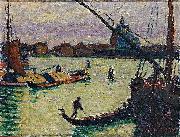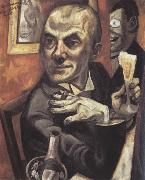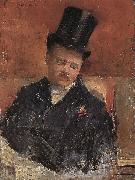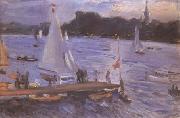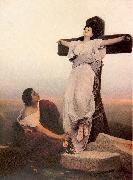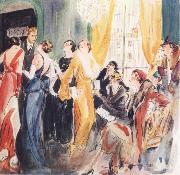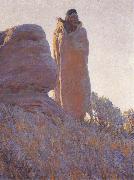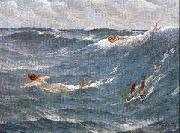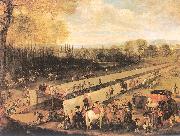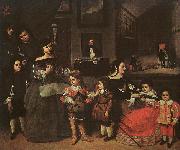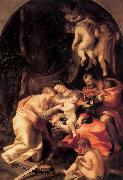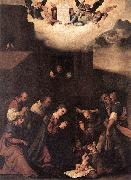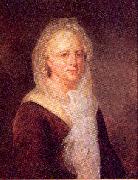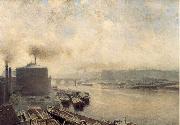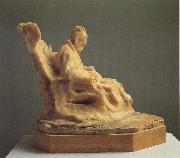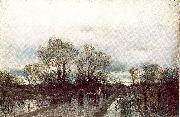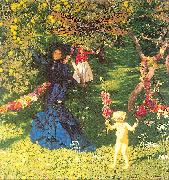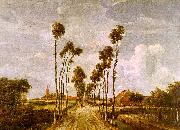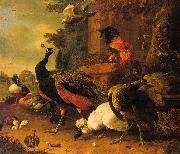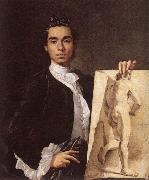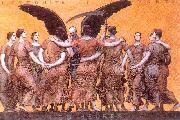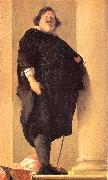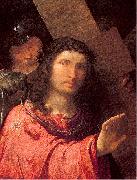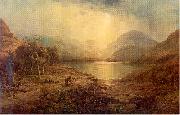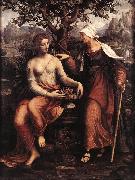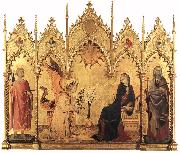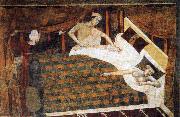|
|
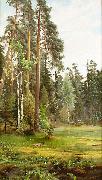 |
Mauritz Lindstrom
|
|
(26 April 1849 - 11 December 1923) was a Swedish painter. He was born in Västmanland and studied at the Royal Swedish Academy of Arts in Stockholm, in 1869 - 72. He went to Munchen and Paris to continue his studies, and lived in England from early 1880s to 1889. Lindström is best known today for his landscapes.
|
|
 |
Maurycy Gottlieb
|
|
Drohobytsch, February 21/28, 1856 - Krakew, July 17, 1879) was a Jewish painter, of Polish-speaking Galician Jews from the western part of Ukraine. He was born in Drohobych (at that time Austria-Hungary), Galicia, modern Lviv region, western Ukraine.
Maurycy was one of Isaac and Fanya Tigerman Gottlieb's eleven children. At fifteen, he was enrolled at the Vienna Fine Arts Academy. Later, he would study under Jan Matejko in Krakew. However, he experienced anti-semitism from his fellow students, and left Matejko's studio after less than a year, he then traveled to Norway settling in Molde. After several years he returned to Vienna to pursue his Jewish roots.
At twenty, he won a gold medal from a Munich art competition for Shylock and Jessica (at right), showing a scene from Shakespeare's The Merchant of Venice. He based Jessica's face on that of Laura Rosenfeld, to whom he had proposed marriage. However, Rosenfeld rejected his proposal, and wed a Berlin banker. Gottlieb then planned to marry Lola Rosengarten, but when he heard about Rosenfeld's marriage he committed suicide by exposure to the elements, dying of complications from a cold.
Despite his early death, more than three hundred of his works survive, though not all are finished. After the fall of the Iron Curtain, many Polish collections unknown in the West were discovered, and his reputation grew greatly.
His brother, painter Leopold Gottlieb, was born five years after his death.
|
|
|
|
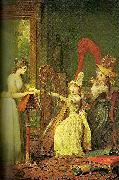 |
mauzaise
|
|
princess adelaide dorleans taking aharp lesson with mme de genlis,c.
1789
versailles, museum |
|
|
|
|
|
|
|
|
|
max ernst
|
|
Max Ernst (2 April 1891 ?C 1 April 1976) was a German painter, sculptor, graphic artist, and poet. A prolific artist, Ernst is considered to be one of the primary pioneers of the Dada movement and Surrealism. |
|
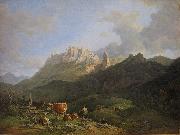 |
Max Joseph Wagenbauer
|
|
Maximilian Joseph Wagenbauer (1775 Grafing - 1829 Munich), was a Bavarian artist.
After finishing school, Wagenbauer attended drawing classes in Munich, under Johann Jakob Dorner the Elder (1741-1813). At the turn of the 19th century he was producing mostly Neo-Classical watercolour landscapes. He served in the military from 1797 to 1801, receiving a royal artist's annuity after his service through the influence of Johann Christian von Mannlich (1741-1822), architect and general building director of the dukes of Zweibre-ken. A condition of the royal stipend was that he produce paintings. He was appointed artist to the court and cabinet in 1802 and Inspector of the Royal Paintings Gallery in 1815. Wagenbauer focused increasingly on oil painting after 1810 and enjoyed the patronage of Maximilian I Joseph of Bavaria, who in 1811 commissioned him, Cantius Dillis (1779-1856) and Johann Jakob Dorner the Younger (1775-1852) to decorate the banquet hall at Schloss Nymphenburg with large paintings of Bavarian lakes. |
|
 |
Max Klinger
|
|
German Symbolist Painter and Sculptor, 1857-1920 |
|
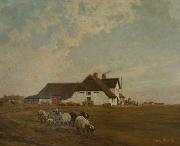 |
Max Koch
|
|
(born July 17, 1854 - April 1, 1925) was a German-born Australian botanical collector.
Born in Berlin, Koch was apprenticed to a merchant's office, but, not liking the work, joined the crew of a Glasgow-based sailing ship at Bremerhaven. He left it at Port Augusta, South Australia in April 1878, taking work at a wheat farm. Later he moved to Mount Lyndhurst sheep station, where he remained for many years. Around 1896 he began serious botanical collecting.
Koch visited Germany around 1902-1903, then returned to Australia, and in 1904 moved to the extreme south-west of Western Australia, where he spent the next 17 years working in the timber industry. By that time he had a large family, and he supplemented his income by plant specimens, and, in his later years, seed. He died at Pemberton, Western Australia in 1925
|
|
 |
Max Kurzweil
|
|
Maximilian Franz Viktor Zdenko Marie Kurzweil (12 (13?) October 1867 Bisenz - 9 May 1916 Vienna) was an Austrian painter and printmaker. He moved near Vienna in 1879.
|
|
|
|
|
|
|
|
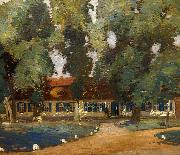 |
Max Uth
|
|
painted Landsitz in der Mark in 1900 |
|
|
|
 |
Maxim Nikiforovich Vorobiev
|
|
(1787-1855) was a Russian Romantic landscape painter.
Vorobiev was born into the family of a soldier, who on retirement became a guard in the Academy of Arts in St. Petersburg. There, Maxim was admitted in 1798 where he initially studied architecture but graduated as a landscape painter in 1809.
|
|
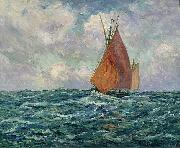 |
Maxime Maufra
|
|
was a French landscape and marine painter, etcher and lithographer.
Maufra first began painting at 18. He was encouraged to do so by two artists from Nantes: the brothers Leduc. However, he didnet fully embrace his painting career right away. Being a businessman, he only painted on his spare time from 1884 to 1890. During this time, Maufra discovered the work of the Impressionists and was able to display his works at the Paris Salon of 1886. In 1890, Maufra decided to give up commerce and to become a full-time painter. He left Nantes for Brittany, where he was able to meet Paul Gauguin and Paul Serusier. Maufra had his first solo exhibition in Paris in 1894, at Le Barc de Toutteville. Returning from Brittany, Maufra was the first painter to take up residence in The Bateau-Lavoir, a famous Parisian residence for artists.
In his paintings, Maufra sometimes quoted the pointillisit technique of Pissarro or Sisley, and also took from the strong colors and powerful drawing of the Pont Aven school. However, Maufra stayed an independent artist his all life through, and dedicated his art to recording the beauty of nature.
|
|
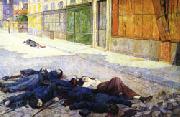 |
Maximilien Luce
|
|
Maximilien Luce (March 13, 1858 - February 6, 1941) was a French Neo-impressionist artist. A printmaker, painter, and anarchist, Luce is best known for his pointillist canvases. He grew up in the working class Montparnasse, and became a painter of landscapes and urban scenes which frequently emphasize the activities of people at work. He was a member of the Groupe de Lagny with Leo Gausson, Émile-Gustave Cavallo-Peduzzi and Lucien Pissarro.
|
|
|
|
|
|
|
|
|
|
|
|
|
|
|
|
|
|
|
|
|
|
|
|
|
|
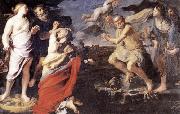 |
MEI, Bernardino
|
|
Italian painter, Roman school (b. 1612, Siena, d. 1676, Roma) |
|
|
|
|
|
|
|
|
|
|
|
|
|
|
|
|
|
|
|
|
|
|
|
|
|
|
|
|
|
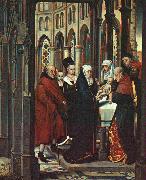 |
MEMLING, Hans
|
|
Netherlandish Northern Renaissance Painter, ca.1435-1494 |
|
|
|
|
|
|











